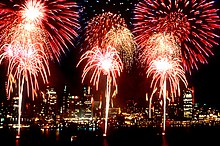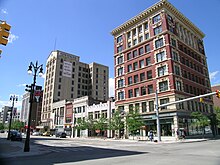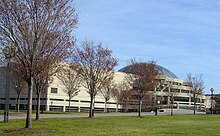The culture of Detroit, Michigan, has influenced American and global culture through its commercial enterprises and various forms of popular music throughout the 20th and 21st century. Its automotive heritage plays an important role in the city's culture.
Entertainment and performing arts

Music has been the dominant feature of Detroit's nightlife since the late 1940s. The metropolitan area boasts two of the top live music venues in the United States. The Pine Knob Music Theatre (formerly DTE Energy Music Theatre), which was the most attended summer venue in the United States in 2005 for the fifteenth consecutive year, while the closed Palace of Auburn Hills ranked twelfth, according to music industry source Pollstar. Detroit's major performance centers include Orchestra Hall, home of the Detroit Symphony Orchestra, the Detroit Opera House, the Fox Theatre, Masonic Temple Theatre, the Fisher Theatre, and the Detroit Film Theatre at the Detroit Institute of Arts.
Throughout the 1950s, Detroit was centre of jazz genre of music, with stars of the era going to Detroit's Black Bottom neighborhood to perform. One highlight of Detroit's musical history was the success of Motown Records during the 1960s and early 1970s, which was founded in Detroit by Berry Gordy Jr. Popular recording acts including Marvin Gaye, Stevie Wonder, and Diana Ross & the Supremes come from Detroit. During the late 1960s, Aretha Franklin, a singer-songwriter from Detroit, became America's preeminent female soul artist, recording on the competing Atlantic Records label.
In the late 1960s, Metro Detroit was the epicenter for high-energy rock music with MC5 and Iggy and the Stooges, the precursors of the punk rock movement. Rock acts from southeast Michigan that enjoyed success in the 1970s were Bob Seger, Ted Nugent & The Amboy Dukes, Alice Cooper, The Romantics, and Grand Funk Railroad as well as more recent acts like Marshall Crenshaw, Kid Rock, The White Stripes, The Von Bondies, and Madonna. The Detroit area is generally accepted as the birthplace of the Techno movement, which has grown from local radio and clubs to dance venues worldwide. The three musicians most frequently credited with giving birth to Techno are Derrick May, Juan Atkins, and Kevin Saunderson. Hip hop rose to prominence in the late nineties with the emergence of Eminem, the rap artist with the highest cumulative sales. Other Detroit hip-hop artists include Insane Clown Posse, Aaliyah, D12, Royce Da 5'9" Teairra Mari, Obie Trice, Trick Trick, Rock Bottom, and the late Blade Icewood, Slum Village.
Birth to a new music culture beginning in the 2010s, Trap music has attracted new audiences and seen huge growth in the mainstream market, new hip-hop artists like Babyface Ray, Payroll Giovanni, Teejayx6, Tee Grizzley, Doughboyz Cashout began to gain popularity.
Fashion
The annual "Fash Bash," a major fashion event, typically held in the Renaissance Center's Winter Garden or the Fox Theatre in August celebrates Detroit Fashion Week. Coordinated by the Detroit Institute of Arts, the event features celebrities and models showcasing the latest fashion trends.
Fashion designers that have enjoyed global success include Anna Sui who was born and raised in the city. The designer draws heavy inspiration from Detroit's music scene of the 1960s and 1970s including local bands such as the MC5.
In 1991, a cultural phenomenon began among hair salons which evolved into the Detroit Hair Wars. Trendsetting salons, like Hair N Shears II, on The Avenue of Fashion, helped usher in this trend. A showcase of fantastical hairpiece creations, often using human hair as the main content, has since become a national trend among African-American hair-styling tours.
Festivals and events


Detroit has three major events that are associated with the automobile industry: the North American International Auto Show (January until 2019, then June), Society of Automotive Engineers world congress (April) and the Woodward Dream Cruise (August). Annual music events in the city include the DEMF/Movement/Fuse-In electronic music festival (May), Concert of Colors (July), Ford Detroit International Jazz Festival (September), Dally in the Alley (September) and Arts, Beats and Eats (September). Annual art events include the Dirty Show International Erotic Exhibition (February), People's Art Festival (August), the DAMNED Exhibition (October), and Noel Night (December).
The Windsor-Detroit International Freedom Festival features a fireworks display over the Detroit International Riverfront and coincides with U.S. Independence day (July 4) and Canada Day (July 1). The Detroit Windsor International Film Festival is a major film festival also shared with the city of Windsor. The New Center summer events and Detroit Thunderfest hydroplane races which take place in July. African World Festival and Detroit Fashion Week happen in August. The America's Thanksgiving Parade, originally the Hudson's Thanksgiving Day Parade, is one of the nation's largest and has been held continuously since 1924.
Hosted by the United Irish Societies, the Detroit St. Patrick's Parade is one of the largest St. Patrick's parades in North America and is held annually in Corktown.
The day before Ash Wednesday, or the festival of Mardi Gras/Fat Tuesday, is more frequently celebrated locally as "Paczki Day" by the large Polish population. Many Metro Detroiters join in the festivity by indulging in jelly-filled donuts called paczkis.
The Bayview yacht club sponsors the annual Port Huron to Mackinac Boat Race as well as a number of other regional and local regattas.
Two large LGBT Pride events are held annually in Detroit. Motor City Pride, started in 1972 and currently produced by Equality Michigan, is held the second weekend of June in Hart Plaza and is attended by over 40,000 people. Hotter Than July! is a week-long black gay pride celebration held annually since 1996 is attended by over 20,000 people and produced by the Detroit Black Pride Society and KICK.
Events introduced in the 2010s include the Motown Winter Blast in February and the Detroit River Days in June .
Ethnic culture
Further information: History of DetroitGreektown Historic District is a popular restaurant and entertainment district established by Greek immigrants and residents, having many restaurants that serve Greek cuisine, as well as one of the city's three casinos, Hollywood Casino. Certain buildings on Monroe Street are themed to resemble the Parthenon, Pegasus, and other forms of Greek architecture. Greek music is played on Monroe Street throughout the day. Well-known restaurants include The Laikon Cafe, Cyprus Taverna, Pegasus Taverna, and Pizza Papalis. St. Mary Roman Catholic Church, founded by German immigrants, is located in the heart of the district. Jacoby's German Biergarten (1904), the city's oldest surviving pub, provides a small performance space for up & coming acts in nearby Bricktown. German immigrants also founded St. Joseph Roman Catholic Church on the city's central east side, near the Eastern Market Historic District. Immigrants contributed to the area's notable architecture, especially during the Gilded Age.
Corktown Historic District is the oldest surviving neighborhood in Detroit, dating to the 1850s. The name comes from the Irish immigrants who settled there; they were predominantly from County Cork. The neighborhood is primarily residential, but the district does include some commercial buildings, mostly along Michigan Avenue.

Mexicantown had a 6.9 percent population rise to 96,000 from 1990 to 2000, the city's revitalized Mexicantown has improved the local economy. About half the residents are Hispanic, 25% are African-American, 20% are White and 5% are Arab-American, according to the Southwest Detroit Business Association. It is known for Mexican cuisine at restaurants such as Mexican Village, Evie's Tamales, El Zocalo and Xochimilco. Restaurants, bakeries, and shops are located on Vernor Highway. Mexicantown has had a thriving economy in the 2000s, as evidenced by new housing and increased business openings. Ste. Anne de Detroit Catholic Church is north of the Ambassador Bridge. West Vernor-Junction Historic District, another largely Hispanic neighborhood, which contains the Most Holy Reedemer Church is adjacent to Mexicantown.
The Detroit area's diverse population includes French, Belgian, German, Hispanic, Polish, Greek, Italian, Middle Eastern, and Black populations, with each adding its rich cultural traditions. Detroit became famous for its music legacies; major blues singers, big bands, and jazz artists—such as Duke Ellington, Billy Eckstine, Pearl Bailey, Ella Fitzgerald, and Count Basie—regularly performed in night clubs.

The east necklace of downtown links Grand Circus and the stadium area to Greektown along Broadway. The east necklace contains a sub-district sometimes called the Harmonie Park District in the Broadway Avenue Historic District which has preserved part of the renowned legacy of Detroit's music from the 1930s through the 1950s and into the present. The historic Harmonie Club and Harmonie Centre are located along Broadway. The Harmonie Park area ends near Gratiot and Randolph. Near the Detroit Opera House, and emanating from Grand Circus along the east necklace, are other venues including the Music Hall Center for the Performing Arts and the Gem Theatre and Century Club.
In 1959, Berry Gordy founded Motown Records, one of the first black-owned record labels. Over the next decade, a number of top artists, including The Supremes, The Temptations, Stevie Wonder and Marvin Gaye, signed with the label. The Second Baptist Church once served as "station" for the Underground Railroad. A monument to the Underground Railroad was erected in 2001 at Hart Plaza downtown.
The Shrine of the Black Madonna of the Pan-African Orthodox Christian Church was founded in 1953 by the Rev. Albert B. Cleage. One of the churches' institutions is the Shrine of the Black Madonna Cultural Center & Bookstore, one of the nation's oldest black-owned bookstores.
The Graystone International Jazz Museum documents jazz in Detroit.
Perhaps the most legendary is Joe Louis, heavyweight boxing champion from 1937 to 1949. Louis is memorialized with a sculpture of a giant fist at the intersection of Jefferson and Woodward Avenues, as well as in the name of Joe Louis Arena.
Cultural and social clubs
-
 The world's largest Masonic Temple, the Detroit Masonic Temple serves as home to a variety of fraternal and charitable organizations.
The world's largest Masonic Temple, the Detroit Masonic Temple serves as home to a variety of fraternal and charitable organizations.
-
 Over a century of Detroit business leaders have belonged to the Detroit Club founded in 1882.
Over a century of Detroit business leaders have belonged to the Detroit Club founded in 1882.
-
Private sporting clubs include the Detroit Athletic Club, the Detroit Golf Club, and the Detroit Boat Club
-
 Detroit Yacht Club
Detroit Yacht Club
-
Country Club of Detroit
-
 Since 1934, business leaders have belonged to the Detroit Economic Club.
Since 1934, business leaders have belonged to the Detroit Economic Club.
-
The Scarab Club is an artist's club, gallery, and studio.
-
 The Players clubhouse and theatre.
The Players clubhouse and theatre.
Sister cities
Detroit has seven sister cities, as designated by Sister Cities International:
 Toyota, Japan
Toyota, Japan Dubai, United Arab Emirates
Dubai, United Arab Emirates Turin, Italy
Turin, Italy Kitwe, Zambia
Kitwe, Zambia Minsk, Belarus
Minsk, Belarus Nassau, Bahamas
Nassau, Bahamas Chongqing, P.R. China
Chongqing, P.R. China
Detroit has a long and very close relationship with nearby ![]()
![]() Windsor, Ontario
Windsor, Ontario
See also
- Cinema Petit
- Detroit Historical Museum
- Detroit in literature
- List of films set in Detroit
- List of people from Detroit
- List of songs about Detroit
- Michigan History magazine
References
- DTE Energy Music Theatre Listed as 2004 Top Attended Amphitheatre (1/25/05 Archived December 23, 2005, at the Wayback Machine. DTE Energy Music Theatre.
- Herb Boyd (9/17/97) Cookin' in the Motor City. The Metro Times.
- Harrington, Joe (2002). Sonic Cool: The Life and Death of Rock'N'Roll. Hal Leonard. ISBN 0-634-02861-8., p. 251.
- Bogdanov, Vladimir; Chris Woodstra; Stephen Thomas Erlewine; John Bush (2002). All Music Guide to Rock: The Definitive Guide to Rock, Pop, and Soul (3rd Ed.). Hal Leonard: Backbeat Books. ISBN 0-87930-653-X.
- Bogdanov, Vladimir; Chris Woodstra; Stephen Thomas Erlewine; John Bush (2003). All Music Guide to Hip-Hop: The Definitive Guide to Rap and Hip-Hop. Hal Leonard: Backbeat Books. ISBN 0-87930-759-5.
- Gavrilovich, Peter; Bill McGraw (2000). The Detroit Almanac. Detroit Free Press. ISBN 0-937247-34-0.
- Hodges, Michael H. (September 8, 2003).Fox Theater's rebirth ushered in city's renewal Archived December 5, 2012, at archive.today. Michigan History, The Detroit News
- "General Motors and Fashion Industry Target Breast Cancer Through Concept:Cure" (Press release). General Motors Corporation. PRNewswire.com. October 21, 1997. Retrieved October 28, 2015.
- Eels, Josh (April 5, 2012). "Jack Outside the Box: Jack White Is the Coolest, Weirdest, Savviest Rock Star of Our Time". The New York Times. Retrieved March 23, 2016.
- McGonigal, Mike (March 23, 2016). "How Third Man's giant Detroit location is becoming the ultimate D.I.Y. ecosystem". metrotimes.com. Detroit Metro Times. Retrieved March 23, 2016.
- Boyd, Kayla (November 10, 2015). "Anna Sui talks fashion, success at Michigan Theater". EasternEcho.com. Retrieved January 27, 2016.
- Sarah Klein (April 7, 2004). "Tressed to kill". Metrotimes. Retrieved September 25, 2006.
- "The Dirty Show". The Dirty Show. Retrieved December 27, 2013.
- "DAMNED Exhibition". thatdamnedshow.com.
- "Noel Night". Detroitmidtown.com. Archived from the original on October 31, 2013. Retrieved December 27, 2013.
- Everyone Loves a Parade Archived June 3, 2006, at the Wayback Machine. The Parade Company.
- Baetens, Baetens (March 6, 2019). "Corktown's St. Patrick's Parade celebrates Detroit's Irish heritage". The Detroit News. Retrieved March 7, 2019.
- Robert Strybel (2/5/01). Polish fast food in America?. polartcenter.com.
- "LGBT supporters pack Hart Plaza for biggest Motor City Pride in history". The South End. June 9, 2011. Retrieved June 7, 2013.
- Collins, Andrew. "Hotter Than July 2013 – Detroit Black Gay Pride 2013". About.com. Archived from the original on December 11, 2013. Retrieved December 6, 2013.
- "Motown Winter Blast". Winterblast.com. Retrieved January 15, 2014.
- "Detroit River Days". Detroit River Days. Archived from the original on February 18, 2015. Retrieved December 27, 2013.
- "see neighborhoods". Cityscape Detroit. Archived from the original on December 15, 2013. Retrieved December 27, 2013.
- ^ Williams, Corey (February 28, 2008).New Latino Wave Helps Revitalize Detroit. USA Today. Retrieved December 12, 2010.
- Baulch, Vivian M. (September 4, 1999). Michigan's greatest treasure – Its people Archived July 31, 2007, at archive.today. Michigan History, The Detroit News. Retrieved December 12, 2010.
- Harmonie Park District Archived May 9, 2015, at the Wayback Machine.Retrieved on August 23, 2009.
- The Graystone International Jazz Museum Archived September 11, 2009, at the Wayback Machine
- Swinging Through Time: The Graystone Museum and the story of Detroit jazz Archived May 1, 2008, at the Wayback Machine
- "Sister Cities Program | City of Detroit". www.detroitmi.gov. Archived from the original on June 29, 2010. Retrieved July 1, 2010.
- "International Sister Cities". City.toyota.aichi.jp. Archived from the original on January 17, 2010. Retrieved July 1, 2010.
- "Città di Torino – Relazioni Internazionali". Comune.torino.it. April 7, 1998. Archived from the original on May 27, 2010. Retrieved July 1, 2010.
External links
- City of Detroit – Culture
- Collection: "Detroit-Area Artists" from the University of Michigan Museum of Art
- Guide to Museums in Detroit
 | ||